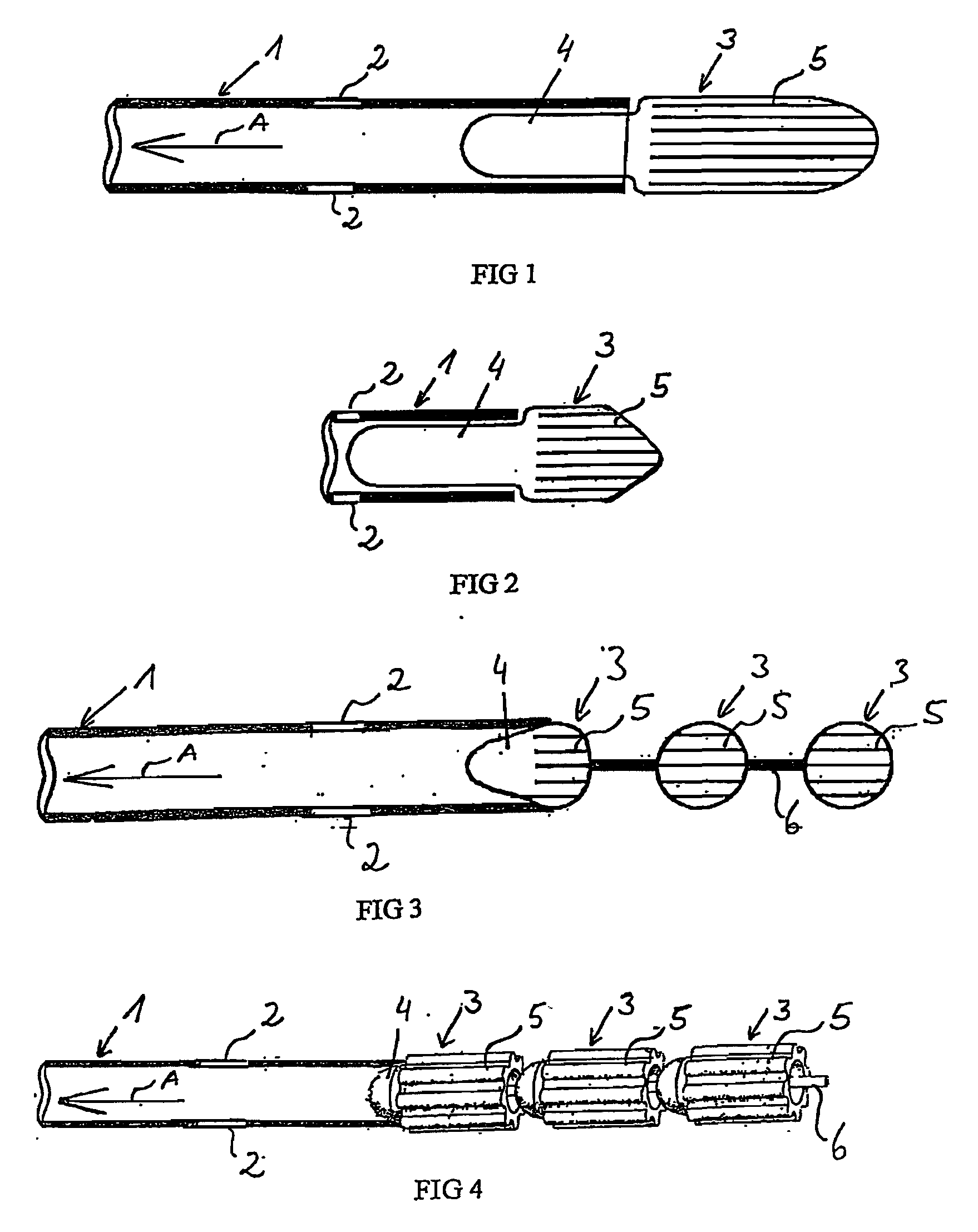[0013]The invention has realized that the amount of antibacterial
active ingredient material dispensed via the surface of the material depot depends on the content of the active ingredient material in the carrier or depends on the loading of the
carrier material with the active ingredient material, and that this content or load by the
carrier material is subject to a predefined upper limit. The invention has likewise realized that the antibiotic from the
carrier material is only released from the uppermost layer of the carrier material. During examinations of explanted gentamycin-PMMA chains, also known as Septopal® chains to a person skilled in the art, and also of explanted gentamycin-containing
bone cement material when prostheses were replaced, it could be verified that the antibiotic material gentamycin is only released from the outer region, which is a few millimeters thick, while the deeper
layers have unchanging proportions of
antibiotics. Moreover, the invention has realized that increasing the surface of the material depot makes it possible to release more antibiotic per unit time, that is to say a sufficiently high level of
antibiotics can be set, even if there is a rapid removal of the antibiotic, with the wound
secretion and other fluids, through the openings of the suction tube. This makes it possible to counteract under-dosage of the
antibiotics. The high local concentration of antibiotics leads to an effective destruction of not only sensitive
pathological germs, but also of partially resistant germs.
[0015]The surface of the material depot can be increased by means of the most diverse surface structures, for example by depressions, hollow recesses, indentations and protuberances such as channels, folds, slits, lamellae, combs and bores. The channels, folds and slits are established along, across or, in a thread-like manner, in the surface of the material depot, preferably along the aspiration drainage tube axis or in a thread-like manner about the aspiration drainage tube axis. Advantageously, the surface structures do not damage, irritate or negatively affect the tissue in situ. Thus, the material depot advantageously does not have sharp edges so that damage to the tissue, the nerves and the vessels, and secondary hemorrhage can be avoided to the greatest possible extent during the removal of the aspiration drainage
system. The arrangement according to the invention of channels, folds and slits along the aspiration drainage tube axis supports the unimpeded slipping of the aspiration drainage system when being pulled out of the wound.
[0016]The depths or heights of the surface structures are expediently selected such that, on the one hand, the stiffness of the carrier material is not negatively affected and, for example, an undesired breaking-off of carrier material is avoided during the
insertion or removal of the suction tube with the terminally arranged material depot; on the other hand, the material thickness between the adjacent structures of the material depot is so thick that an active ingredient, which is as effective as possible, is dispensed from the carrier material in the wound. Thus, by way of example, lamellae, that is to say long longitudinal grooves, have a very large surface and stability measured in terms of the material expenditure, in particular when they are arranged in groups with their surfaces parallel or approximately parallel to each other and are connected to one another. If it is taken into account that the antibiotic material gentamycin is only released from the carrier material PMMA in the wound from an enveloping region which is a few millimeters thick, the material thickness between the adjacent structures of the material depot should preferably only be a few millimeters, preferably at most 5 mm, more preferably 3 mm, particularly preferably 1 to 3 mm.
[0020]The basic geometric shape of the material depot, formed by the envelope, is preferably a shape selected from the group composed of cylinder, sphere, cone and the combination of these basic shapes such as the teardrop shape. In principle, every basic shape is preferred which permits, gently for the patient, the
insertion of the end of the suction tube with the material depot into the body and / or the removal thereof. “Gently” means in particular that the wound opening for inserting and / or removing the suction tube with the material depot can be kept as small as possible, but nevertheless permits simple removal.
[0021]The aspiration drainage system according to the invention can furthermore have a chain of material depots of the type according to the invention at the end of the suction tube to be inserted into the body. In other words, the material depot arranged at the end of the suction tube to be inserted into the body is lengthened by at least one further material depot in the manner of a chain element. The chain elements can be arranged on a central wire. The chain elements can, for example, have a spherical basic shape, analogous to the Septopal® chains known from the prior art, or the shape of a roller, for example in the shape of a
solid cylinder. The adjacent chain elements can also have surfaces which correspond to each other. The surfaces can, for example, be of convex-concave design. This affords the possibility of an articulated movement of the chain elements which makes it easier to insert the aspiration drainage system into the body, (re)position it if required or remove it, even in the case of a small distance between the adjacent chain elements. Such forms of chains have the
advantage that they are flexible and can be matched to the local conditions.
 Login to View More
Login to View More  Login to View More
Login to View More 

